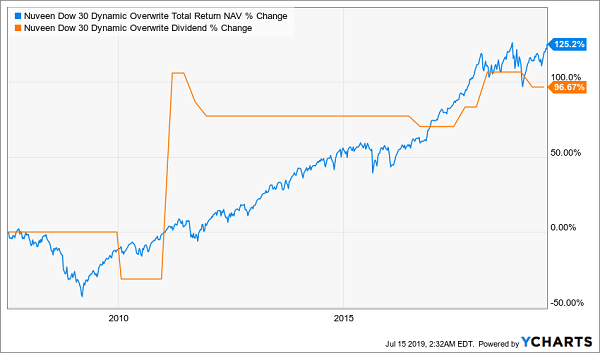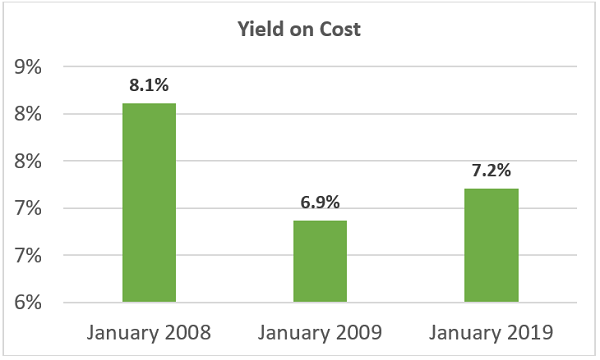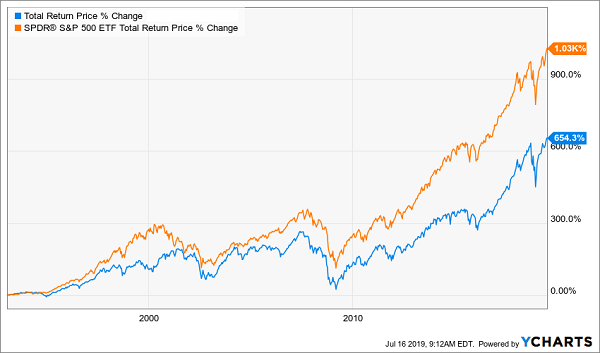Today we’re going to dive into a question subscribers to our CEF Insider service often ask: what happens to a closed-end fund’s dividend when stocks take a tumble?
The answer is coming up shortly (and if you’re at all worried about this levitating market suddenly snapping back, you’re going to like what I have to show you).
Then I’m going to reveal one 6.6%-paying fund whose management is dialed in to market swings and know how to protect their investors’ income when things get rough.
How do I know? Because they did just that in the 2008-09 crisis.
More on that shortly. First, let’s step back and talk about what a 6.6%+ income stream can do for you when the market throws a fit.
CEF Dividends: Critical Portfolio Protection
If you’re leaning on your portfolio for income, the most obvious advantage of a 6.6% dividend is its size: with the benchmark SPDR S&P 500 ETF (SPY) yielding a measly 1.8%, you’re already getting almost four times more income than the typical investor who buys today would bring in.
There’s a lot more to like about an income stream like that, though. And this is where a potential downturn enters the picture.
Imagine, for example, that we have another 2008-2009–style crash and stocks tank 50%. If your portfolio yields the S&P 500 average and you need 6% returns to pay the bills and put food on the table, you’ll have to sell some of your holdings, because your dividends, on their own, aren’t enough to make ends meet.
But if you have 6.6% dividends, you don’t need to sell a thing—you can sit back, collect your payouts and wait out the market volatility.
You don’t even have to go back to the financial crisis to see this “dividend safety net” in action—a lot of income investors used it just last year. When the market fell by over 12% in the span of months, SPY holders in need of cash from their portfolios would have been forced to sell their holdings for 12% less than they would have a few months earlier.
Not so for those relying on the fund I want to spotlight for you today: the 6.6%-yielding Nuveen Dow 30 Dynamic Overwrite Fund (DIAX). If you owned this CEF last year, you didn’t have to sell a thing until stocks recovered!
6.6% Dividend Gives Investors Much-Needed Cover

By the way, this doesn’t only hold for DIAX. Many other CEFs, like the Eaton Vance Tax Advantaged Dividend Income Fund (EVT) and Adams Diversified Equity Fund (ADX) continued to pay out their 6%+ dividend yields throughout last year’s volatility. And DIAX and this pair all caught up with the index in a few short months:
High Dividends Keep CEF Investors in the Money

But how is this possible?
Active Management Preserves Your Income
CEFs are similar to more familiar exchange-traded funds in that they are pools of different investors’ cash that are put in a portfolio of assets. But there are two important differences.
One is that ETFs are open-ended, meaning they can take more capital and become bigger and bigger. That’s why SPY has $280.6 billion in assets, while the similar Nuveen S&P 500 Dynamic Overwrite Fund (SPXX) has just $265.2 million. Big funds are easy to manage if they take a passive strategy, like just buying all of the S&P 500, which is why most ETFs are passive or follow very specific rules.
CEFs are different. Due to their smaller size, fund managers can manage portfolios to maximize income. Say, for instance, a Great Recession–style downturn happens again. A good CEF manager will maintain a mixture of non-correlated stocks in a diversified portfolio of hundreds of assets. Then they can hold on to the ones that are temporarily at a loss during a downturn.
This can even be done with a relatively simple mandate like that of DIAX: the fund aims to replicate the price movements of the Dow Jones Industrial Average—names like Home Depot (HD), Apple (AAPL) and Walt Disney Co. (DIS). In addition, DIAX uses covered-call options to boost the fund’s income stream.
As a result, DIAX’s income stream quickly recovered from a short-term dip during the Great Recession:
A Carefully Managed Dividend

Note that there is a delay between the market downturn and the fund’s dividend reduction. While stocks crashed in 2008-2009, DIAX’s dividend stayed at a constant at 15 cents per share, only dropping to 10.3 cents per share in 2010, after the fund’s value had almost fully recovered.
Then, after a brief pause, dividend growth resumed.
These were deliberate decisions to ensure that investors had the income they needed during a dire market, and they’re the kind of decisions good CEF managers make to protect their investors from needing to sell when stocks are down.
For DIAX holders, the result had been a pretty steady income stream of around 7%. If you’d bought DIAX at the start of 2008, 2009 and 2019, your yield on cost would have stayed at a similar level:
 Source: CEF Insider
Source: CEF Insider
This means that the income stream has remained reliable for shareholders no matter when they buy. If you get DIAX, you’ll get a pretty solid income stream yielding around 7% whenever you buy.
— Michael Foster
Buy This Growing 10.7% Dividend Now—While It’s Still a Bargain [source]
I’ve found a way for you to bulk up your portfolio’s safety and bag an even bigger payout than DIAX’s 6.6% dividend. I’m talking about a mammoth 10.7% income stream that would make your typical S&P 500 sick with envy.
That’s the dividend paid out by my top stock-focused CEF pick now. I’ve issued a buy alert on this top-secret equity CEF for 2 reasons:
- It boasts an amazing 10.7% dividend yield.
- Its cash payout is growing, up an incredible 143% in the last decade!
How does this fund do it?
It’s run by an investment all-star team cherry-picked from 5 of the sharpest management firms on Wall Street.
Together, this crew invests in a “no-gimmicks” portfolio of value and growth stocks, all of which have deep moats protecting their businesses: names like Visa (V), Microsoft (MSFT), Alphabet (GOOGL) and Abbott Laboratories (ABT).
So how has this all-star team performed?
They’ve dominated—and critically, most of my pick’s monstrous total return since inception came in cash, thanks to its big dividend payout:
Crushing the Market in Cash

Finally, this fund trades at an absurd 5% discount to net asset value (NAV, or the market value of the stocks in my pick’s portfolio). It’s only a matter of time before that discount evaporates and shifts to a big premium. When it does, it will propel my pick’s market price higher, handing you some very nice price upside to go along with your 10.7% dividend payouts.
That’s not all! I’ll also give you my 3 other top cash-spinning CEF picks (combined yield: 8.7%; price upside: 20%), too. Don’t miss out. Click here now!
Source: Contrarian Outlook


